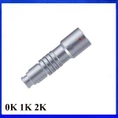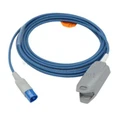Hey there! As a supplier of infrared thermometers, I've seen firsthand how these devices have become a staple in many households and medical settings. They're convenient, quick, and non-invasive, which makes them a popular choice for checking temperatures. But like any product, they're not without their drawbacks. In this blog post, I'll dive into the disadvantages of infrared thermometers to give you a more well-rounded view.
1. Accuracy Concerns
One of the biggest issues with infrared thermometers is accuracy. These devices measure the infrared energy emitted from the body's surface, usually the forehead or ear. However, several factors can affect the accuracy of these readings.
For starters, environmental conditions play a huge role. If the room is too hot or cold, it can impact the temperature reading. For example, if someone has been outside in the cold and then comes indoors to have their temperature taken, the reading might be lower than their actual body temperature. Similarly, if the thermometer is exposed to direct sunlight or a heat source, it can give inaccurate results.
Another factor is the presence of sweat or moisture on the skin. Sweat can act as a cooling agent, causing the thermometer to read a lower temperature than the person's core body temperature. Also, if the person has just washed their face or has a wet forehead, it can skew the reading.


Moreover, the distance between the thermometer and the body is crucial. Most infrared thermometers need to be held at a specific distance from the forehead or ear to get an accurate reading. If the user doesn't follow the instructions correctly and holds the thermometer too far away or too close, the result can be inaccurate. Our Baby Digital Infrared Thermometer Forehead Medical Non Contact Temperature LCD Thermometer Portable comes with clear instructions on the optimal distance, but it still requires the user to be careful.
2. Limited to Surface Temperature
Infrared thermometers measure the surface temperature of the body, not the core body temperature. The core body temperature, which is the temperature of the internal organs, is a more accurate indicator of a person's health. Surface temperature can vary depending on external factors, as mentioned earlier, and may not always reflect the true state of a person's health.
For instance, a person might have a normal surface temperature on their forehead but still have a fever due to an internal infection. In such cases, an infrared thermometer might not detect the underlying issue. This is especially important when it comes to diagnosing illnesses like the flu or COVID - 19, where an accurate temperature reading is crucial. Our Multi-use Digital Infrared Baby Thermometer Gun Non-Contact Forehead Ear Temperature Measurement Tool For Newborn Baby Adults is great for quick checks, but it's important to keep in mind its limitations.
3. Cost
Infrared thermometers can be more expensive than traditional mercury or digital thermometers. The technology used in these devices is relatively new and more complex, which drives up the cost. For some consumers, especially those on a tight budget, this can be a deterrent.
Also, if the thermometer breaks or malfunctions, the cost of repair or replacement can be high. Unlike traditional thermometers, which are often inexpensive to replace, infrared thermometers require specialized parts and sometimes professional servicing.
4. Battery Dependency
Most infrared thermometers are battery - operated. This means that if the batteries run out, the thermometer won't work. It can be frustrating, especially in an emergency situation when you need to take someone's temperature right away.
Moreover, constantly replacing batteries can add to the overall cost of using the thermometer. And if the user forgets to replace the batteries in time, they might end up with a non - functioning thermometer when they need it most. Our Forehead Non-Contact Digital Thermometer is battery - powered, so it's important for users to keep spare batteries on hand.
5. Calibration Requirements
Infrared thermometers need to be calibrated regularly to ensure accurate readings. Calibration is the process of adjusting the thermometer to match a known standard. Over time, the internal components of the thermometer can wear out or become misaligned, which can affect its accuracy.
Calibrating an infrared thermometer can be a complicated process that requires specialized equipment and knowledge. Not all users are equipped to do this themselves, and taking the thermometer to a professional for calibration can be time - consuming and costly.
6. False Sense of Security
Because infrared thermometers are so convenient and quick to use, some people might rely on them too heavily and develop a false sense of security. They might assume that if the thermometer shows a normal temperature, the person is healthy. However, as we've discussed, these thermometers have limitations, and a normal surface temperature doesn't always mean a person is free from illness.
This false sense of security can be dangerous, especially in a public health context. For example, in a workplace or school setting, relying solely on infrared thermometers to screen for fevers might miss cases of illness, leading to the spread of infectious diseases.
Conclusion
Despite these disadvantages, infrared thermometers still have their place. They're great for quick temperature checks, especially for children or when you don't want to make physical contact. But it's important to be aware of their limitations and use them in conjunction with other methods of temperature measurement when necessary.
If you're interested in purchasing our infrared thermometers, we offer a range of high - quality products that are designed to minimize some of these drawbacks. We're always happy to discuss your needs and answer any questions you might have. Whether you're a healthcare provider, a school administrator, or just a concerned parent, we can help you find the right thermometer for your situation. Reach out to us to start a procurement discussion, and let's work together to find the best solution for you.
References
- American Academy of Pediatrics. "Thermometers and Taking Your Child's Temperature."
- World Health Organization. "Guidelines on the Use of Non - Contact Infrared Thermometers."




